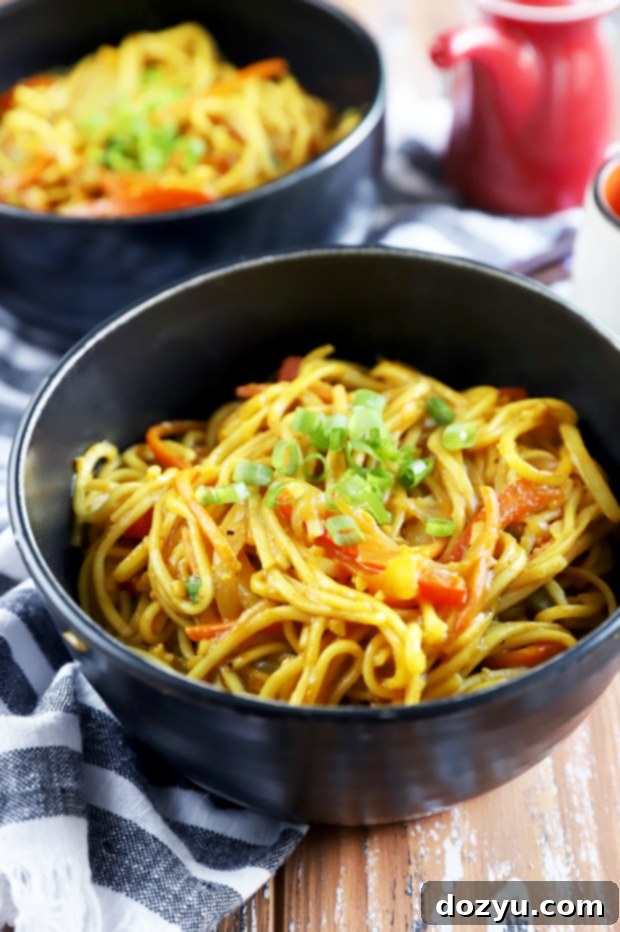Easy & Flavorful Singapore Street Noodles: Your 15-Minute Takeout Fakeout Recipe
Get ready to bring the vibrant flavors of Asian street food right into your kitchen with this incredibly simple and delicious Singapore Street Noodles recipe! In just 15 minutes, you can create a dish that’s a perfect harmony of sweet, savory, and a delightful touch of spice. This recipe is a fantastic choice for a quick vegetarian night, but it’s also incredibly versatile. Feel free to liven things up by adding leftover cooked chicken, succulent shrimp, tender pork, or savory beef to make it a hearty meal. The bright yellow hue, courtesy of curry powder, and the aromatic blend of ginger and garlic make these noodles an unforgettable experience.
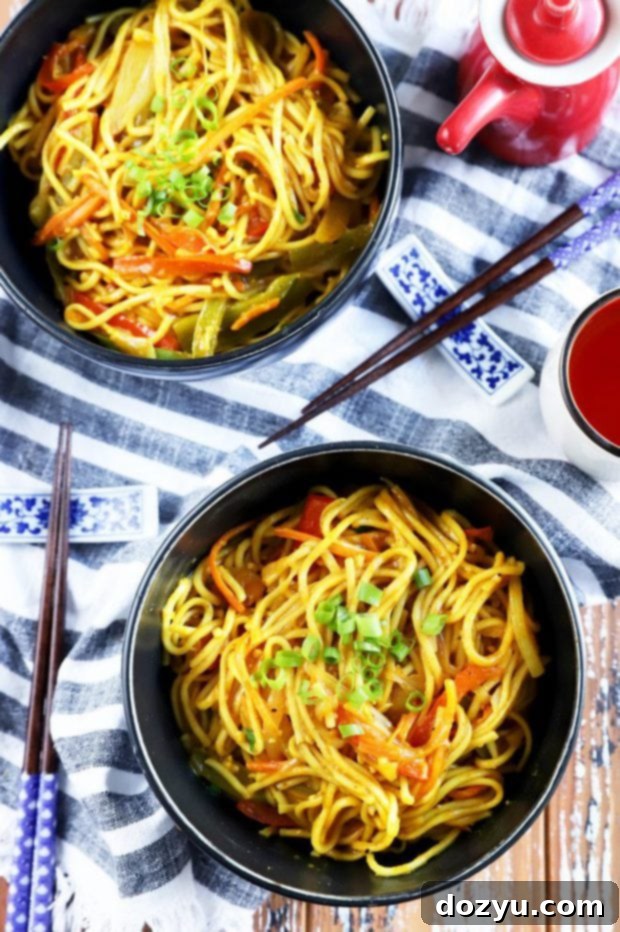
About These Singapore Street Noodles: A Culinary Journey
My first encounter with Singapore street noodles was watching a captivating episode of Top Chef, where finalists explored the bustling food markets of Singapore. The sheer variety and aroma of the street food were incredible, but it was the vibrant, curry-infused noodles that truly captured my imagination. While the exact origin of Singapore noodles is a topic of friendly debate – some suggest Hong Kong, while others point to Singapore – one thing is universally agreed upon: their unique flavor profile and the signature yellow color derived from curry powder.
These noodles are a fantastic canvas for customization. Whether you prefer a wholesome vegetarian meal brimming with fresh vegetables or desire to incorporate your favorite proteins, this recipe adapts effortlessly. It’s an excellent way to utilize leftovers, transforming shredded chicken or pork into a brand new exciting dish. You can even quickly cook some fresh shrimp directly in the pan for a delightful seafood twist.
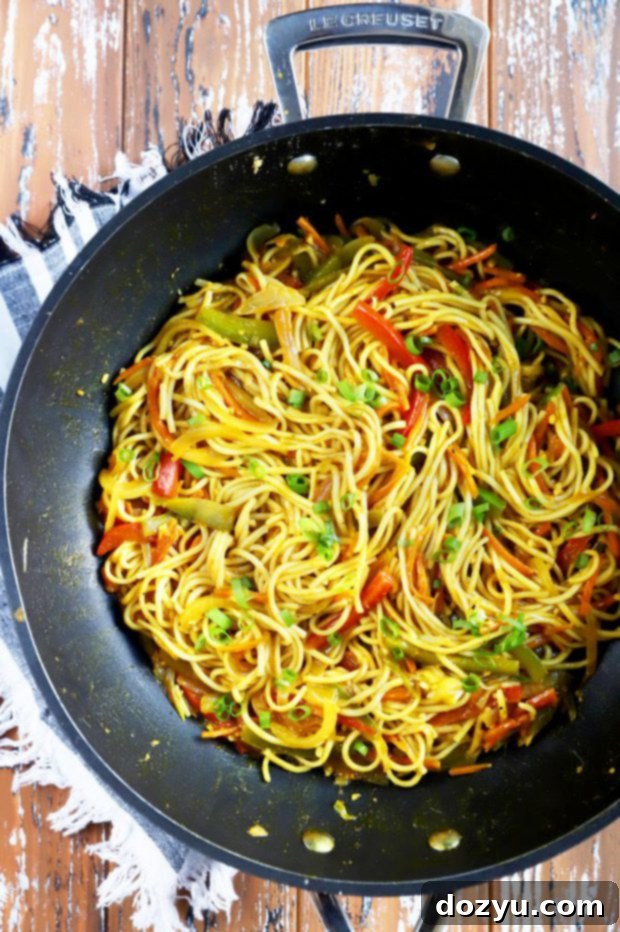
Why You’ll Love This Quick & Easy Singapore Noodle Recipe
- Lightning Fast: This entire dish comes together in just 15 minutes, making it an ideal choice for busy weeknights when you crave something delicious without spending hours in the kitchen.
- Flavor Explosion: Experience a complex blend of sweet, savory, tangy, and a touch of spicy, all balanced by the earthy warmth of curry. It’s truly a feast for the taste buds!
- Infinitely Customizable: This recipe is a perfect base. Keep it vegetarian, add your favorite protein (chicken, shrimp, beef, tofu), or load it up with extra vegetables. It’s your culinary playground!
- Health-Conscious & Fresh: Packed with fresh bell peppers, carrots, onions, and garlic, it’s a wholesome meal that tastes incredible. You control the ingredients, ensuring a fresher, healthier option than typical takeout.
- Budget-Friendly: Often made with pantry staples and common vegetables, this recipe is a cost-effective alternative to ordering in.
Essential Ingredients for Authentic Flavor
To create the perfect plate of Singapore Street Noodles, here’s a detailed look at the key components and why they matter:
- Thin Rice Noodles (Vermicelli): These delicate noodles are the star! Their thin strands absorb the flavorful sauce beautifully, providing a wonderful texture that’s not too heavy. Look for “rice vermicelli” in the Asian aisle of your grocery store.
- Sesame Oil: Derived from sesame seeds, this oil boasts a deeply aromatic and nutty flavor. It’s potent, so use it sparingly to avoid overpowering the dish. It adds a crucial layer of authentic Asian taste.
- Bell Peppers: I highly recommend using two different colored bell peppers – perhaps orange, red, or yellow. Not only do they add a lovely visual pop to the dish, but each color offers a slightly different sweetness and crisp-tender texture.
- Shallots & Onion: Shallots provide a milder, sweeter, and more nuanced onion flavor than regular onions. When combined with a sweet onion (like Vidalia), they create a delightful aromatic base that enhances the overall savoriness of the noodles.
- Carrots: Whether you prefer to peel and shred them yourself or opt for the convenience of pre-shredded carrots, they add a touch of sweetness, vibrant color, and a pleasant crunch.
- Fresh Ginger: You’ll need ginger in two forms: roughly chopped for sautéing with the vegetables to infuse the oil with a pungent aroma, and minced (or ginger paste, my preferred shortcut) for the sauce, where its zesty flavor can meld perfectly.
- Fresh Garlic: Similar to ginger, garlic is used for both sautéing (roughly chopped) and in the sauce (minced or garlic paste). Fresh garlic is essential for that signature fragrant depth.
- Mirin: This is a subtly sweet Japanese rice wine, a secret weapon in many Asian-inspired dishes. It adds a unique depth and sweetness that balances the savory and spicy elements. If you can’t find mirin, a dry white wine or rice vinegar with a pinch of sugar can be used as a substitute, though the flavor will be slightly different.
- Green Onions (Scallions): Sliced green onions are not just a garnish; they add a fresh, mild oniony bite that brightens the entire dish and provides a welcome textural contrast.
- Broth (Low-Sodium): Use either low-sodium chicken or vegetable broth. Opting for low-sodium allows you to control the overall saltiness of the dish, especially since soy sauce is also used.
- Soy Sauce (Low-Sodium): Like the broth, low-sodium soy sauce is recommended for better control over the seasoning. Adjust to your taste, or use regular soy sauce if that’s what you usually have on hand.
- Curry Powder & Turmeric: These are the star spices that give Singapore Street Noodles their distinctive yellow color and earthy, aromatic flavor. Invest in high-quality versions for the best results. Curry powder provides the main flavor, while turmeric enhances the color and adds a subtle earthiness.
- Sriracha: This is where the heat comes from! Adjust the amount of Sriracha to your preference. A little adds a pleasant kick, while more will truly amp up the spice level.
- Cornstarch & Water (for Slurry): A simple mixture of cornstarch and water forms a slurry, which is crucial for thickening the sauce to coat the noodles beautifully.
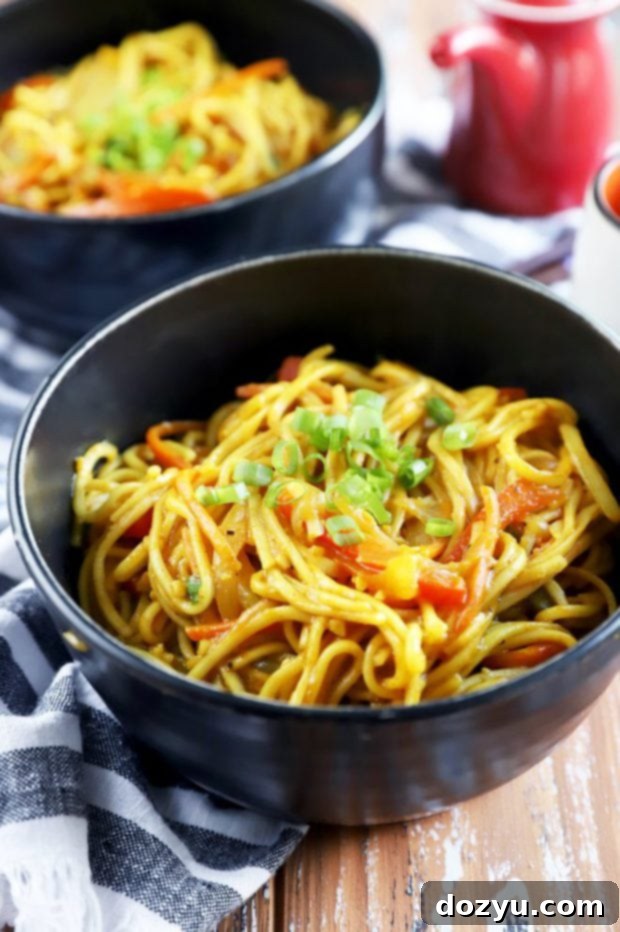
Must-Have Kitchen Tools for Seamless Cooking
You don’t need a lot of specialized equipment to make these noodles, but having a few key tools will make the process even smoother:
- Chef’s Knife & Cutting Board: Essential for efficiently slicing and dicing all your vegetables.
- Wok or Large Nonstick Skillet: A wok is ideal for stir-frying as its sloped sides allow for quick and even cooking, but a large nonstick skillet will work perfectly too.
- Mixing Bowls & Whisk: You’ll need these for preparing the sauce and the cornstarch slurry separately before combining them.
- Large Pot: For boiling the rice noodles.
Looking for more delicious noodle recipes? Explore these other favorites: Instant Pot Bolognese | Flank Steak with Creamy Kale Peanut Noodles | Stir Fry Pasta | Gochujang Noodles with Chicken and Greens | Curry Udon
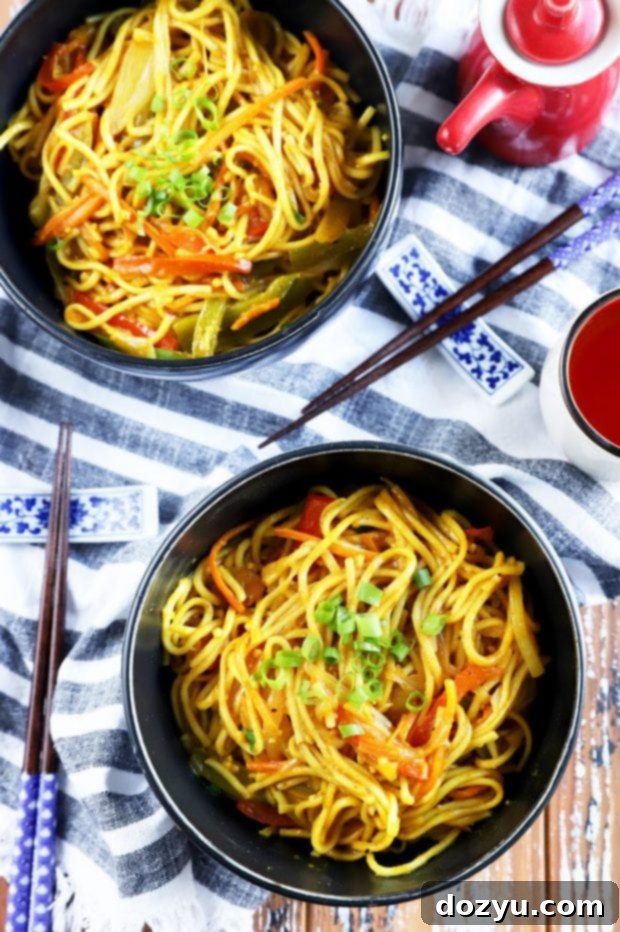
Step-by-Step Guide: Crafting Delicious Singapore Street Noodles
Follow these simple steps to create a mouthwatering meal in no time:
1. Prepare Your Flavorful Sauce & Slurry
In a small bowl, whisk together all the ingredients for your main sauce: broth, soy sauce, curry powder, turmeric, mirin, minced garlic, minced ginger, and sriracha. Set this aside. In a separate very small bowl, whisk together the cornstarch and water to create your slurry. This will be used to thicken the sauce later. Set this aside as well.
2. Perfectly Cook the Rice Noodles
Bring a large pot of water to a rolling boil. Carefully add the thin rice noodles and cook them according to the package directions. Rice vermicelli usually cooks very quickly, often just 2-3 minutes. You want them to be al dente, not mushy. Once cooked, drain the noodles thoroughly and set them aside. You can rinse them with cold water to prevent sticking if you’re not adding them immediately.
3. Sauté Your Vibrant Vegetables
Heat the sesame oil in your wok or large nonstick skillet over medium-high heat. Once the oil is shimmering and hot, add the thinly sliced bell peppers, shallots, onion strips, and shredded carrots. Cook these vegetables, stirring occasionally, for about 5 to 8 minutes, or until they are tender-crisp. You still want them to have a little bite. Next, stir in the roughly chopped fresh ginger and garlic, cooking for another minute or two until they release their fragrant aroma. Once cooked, push all the vegetables over to one side of the pan, leaving the other side empty.
4. Bring It All Together: The Grand Finale
Pour the prepared sauce mixture and the cornstarch slurry into the empty side of the pan. Bring it to a gentle simmer and cook for about 2 minutes, stirring continuously, until the sauce has thickened slightly. Then, stir the cooked vegetables back into the thickened sauce, ensuring everything is well combined. Finally, add the cooked and drained rice noodles to the pan. Use tongs or two spatulas to gently toss everything together until the noodles are evenly coated with the rich, yellow curry sauce. Taste the noodles and season with additional salt and pepper as needed. Serve immediately, garnished with a generous sprinkle of sliced green onions (scallions) on top.
Need some more inspiration for dinner this week? Check out my main dish recipe page!
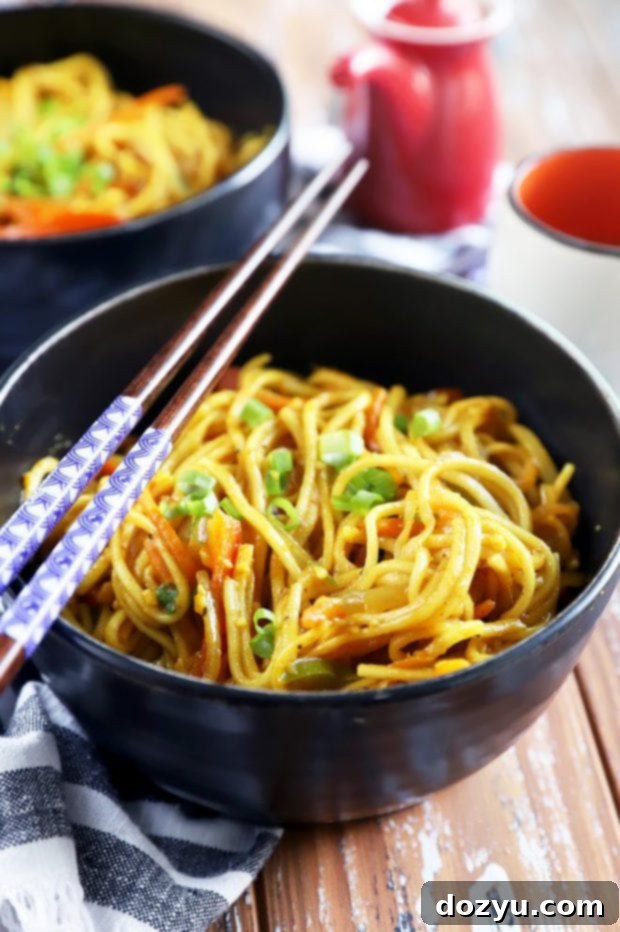
Pro Tips for Singapore Street Noodle Success
- Master the Mise en Place: This 15-minute recipe goes even faster if all your ingredients are prepped and ready before you start cooking. Chop your veggies, mince your garlic and ginger, and mix your sauce and slurry ahead of time. This organized approach ensures a smooth, stress-free cooking experience.
- Power Up with Protein:
- Chicken or Pork: If using cooked, shredded chicken or pork, add it to the pan with the vegetables during the last 2-3 minutes of sautéing to heat through.
- Shrimp: Fresh shrimp cooks very quickly. Add peeled and deveined shrimp to the pan after the vegetables have softened, cooking for only 2-3 minutes until pink and opaque before adding the sauce.
- Tofu: For a vegan option, press extra-firm tofu, cube it, and pan-fry until golden brown before adding it with the vegetables.
- Beef: Thinly slice beef (like flank steak), marinate briefly in a little soy sauce and cornstarch, then quickly stir-fry it in a separate hot pan before adding it to the noodles at the end.
- Boost Your Veggies: Don’t limit yourself to the suggested vegetables! This dish is incredibly flexible. Consider adding shredded cabbage, crisp bean sprouts, tender snow peas, thinly sliced mushrooms, or even chopped bok choy for extra nutrition and texture.
- Go Gluten-Free: To make this recipe gluten-free, simply ensure you use tamari instead of regular soy sauce and verify that your broth is also gluten-free.
- Control Your Noodle Texture: Rice noodles can quickly go from perfectly tender to mushy. Cook them only until al dente. If you’re not immediately adding them to the wok, a quick rinse with cold water after draining can stop the cooking process and prevent them from clumping together.
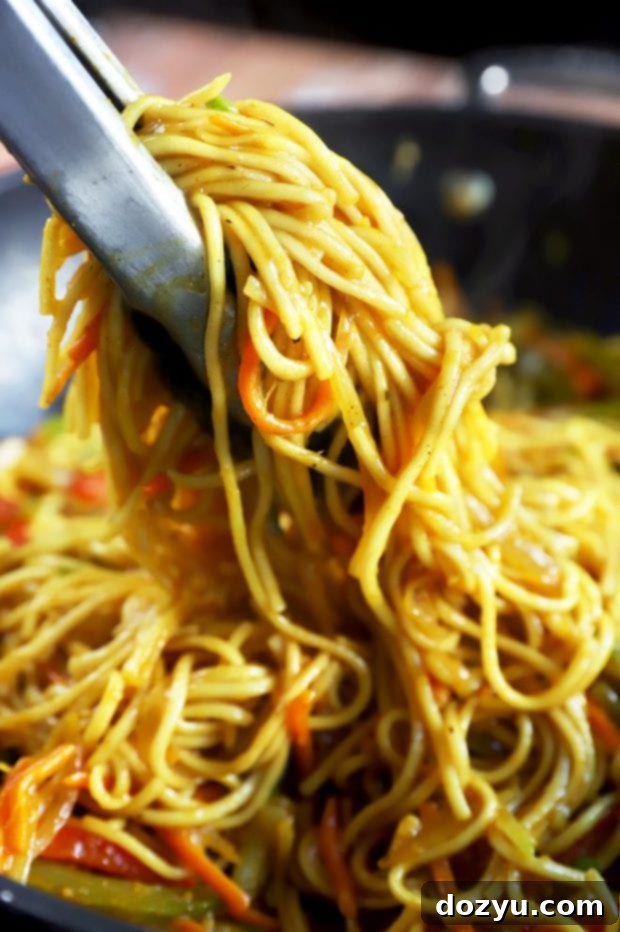
What Do Singapore Street Noodles Taste Like?
Imagine the comforting texture of a Lo Mein or the vibrant flavors of a Pad Thai, but with a unique twist! The defining characteristic of Singapore Street Noodles is the prominent use of curry powder in the sauce. This gives the dish its signature yellow color and an aromatic warmth that sets it apart. The resulting flavor profile is a beautiful symphony: subtly spicy from the Sriracha and curry, distinctly savory from the soy sauce, gently tangy from the mirin, and just a touch sweet. It’s not as liquid-heavy as a traditional Thai curry, but rather features a creamy, well-coating curry sauce that clings perfectly to every noodle and vegetable.
Amping Up the Heat: Customizing Your Spice Level
If you love a fiery kick, it’s incredibly easy to adjust the spice level in this dish. The simplest way is to add more Sriracha to the sauce mixture. You can start with the recommended amount and then add more a teaspoon at a time until you reach your desired heat. For an extra layer of spice, you could also stir in a pinch of red pepper flakes with the vegetables, or even a dash of chili garlic sauce for added depth. If you’re a true spice enthusiast, a few thinly sliced bird’s eye chilies can take this dish to an exhilarating level!
If you’re always on the hunt for more spicy noodle dishes, you might also enjoy this creamy and spicy kimchi udon recipe, which also packs a fantastic punch!
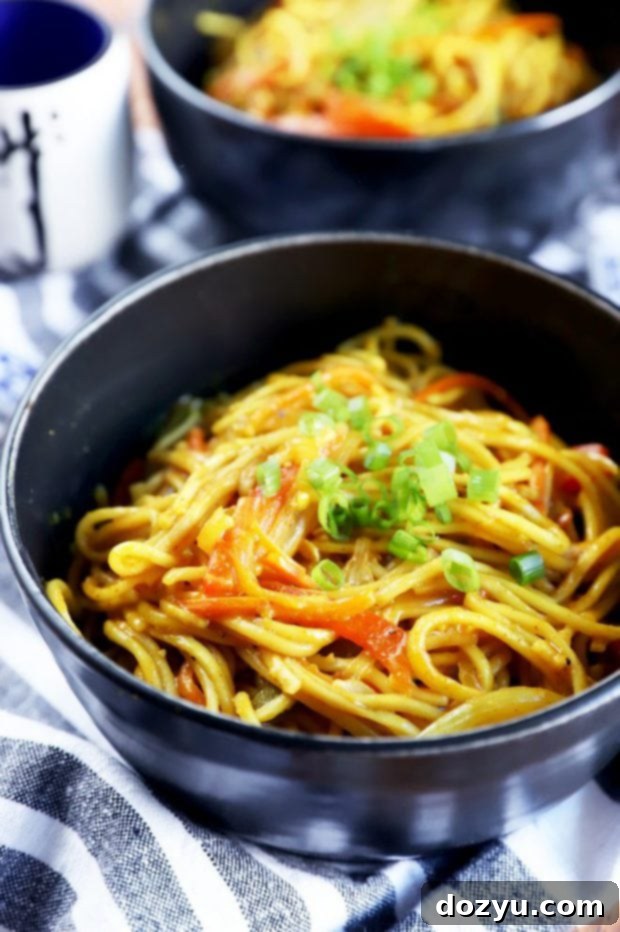
Frequently Asked Questions (FAQ)
- Is this recipe truly authentic to Singapore?
- While commonly called “Singapore Street Noodles,” their precise origin is debated, with many food historians suggesting they likely originated in Hong Kong. Regardless of their true birthplace, they are a beloved dish known for their unique curry flavor and are widely enjoyed as a representation of vibrant Asian street food cuisine.
- Can I make these noodles vegan?
- Absolutely! This recipe is easily adaptable for vegans. Simply use vegetable broth instead of chicken broth and omit any meat protein. You can add pan-fried or baked tofu for a delicious plant-based protein source. Ensure your curry powder and other ingredients are vegan-friendly.
- What kind of rice noodles are best for this recipe?
- Thin rice vermicelli noodles are ideal. Their delicate texture quickly absorbs the sauce, creating a perfect balance of flavors. Avoid thicker rice noodles or egg noodles, as they might not achieve the same desired texture and sauce absorption.
- What if I don’t have mirin? What can I use as a substitute?
- Mirin adds a unique sweetness and depth. If you don’t have it, you can use rice vinegar mixed with a pinch of sugar (about 1/2 teaspoon sugar per tablespoon of rice vinegar) or a dry white wine (like Sauvignon Blanc) for a similar tangy-sweet profile, though the flavor won’t be identical.
- How do I store leftovers, and how long do they last?
- Store any leftover Singapore Street Noodles in an airtight container in the refrigerator for up to 3-4 days. When reheating, you might want to add a tiny splash of water or broth to loosen the noodles and prevent them from drying out.
- Can I freeze Singapore Street Noodles?
- Freezing is generally not recommended for noodle dishes, especially those with thin rice noodles. The noodles can become mushy and lose their desirable texture upon thawing and reheating. It’s best enjoyed fresh or from refrigeration within a few days.
Finally, if you make this Singapore noodles recipe, please be sure to give it a rating or leave a comment! I love to hear when you all make recipes, and I do take the time to respond to every single comment. Feel free to drop questions below too, if you have them!
Oh, and be sure to tag me on Instagram if you make the recipe! I love being able to see these recipes come to life in your homes – it’s my favorite thing to look through those photos. It really means the world to me!
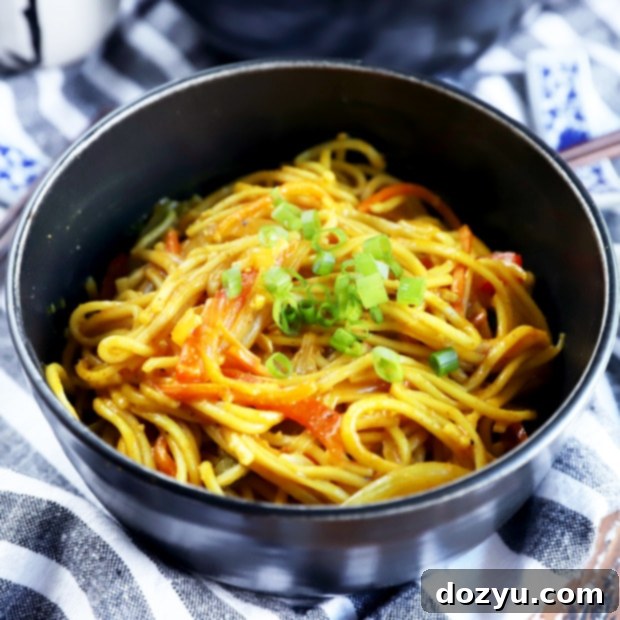
Singapore Street Noodles
A little bit of spicy and a little bit of sweet makes this dish a weeknight winner!
- Prep Time: 5 mins
- Cook Time: 10 mins
- Total Time: 15 mins
Equipment
- Chef’s Knife
- Cutting Board
- Whisk
- Mixing Bowls
- Wok or Large Nonstick Skillet
Ingredients
Noodles
- 8 ounces thin rice noodles
- 1 tablespoon sesame oil
- 2 bell peppers, thinly sliced
- 2 shallots, thinly sliced
- 1 large onion, cut into thin strips
- 1/2 cup shredded carrots
- 1 tbsp fresh ginger, roughly chopped
- 4 cloves garlic, roughly chopped
- Sliced scallions for topping
Sauce
- 1 cup low-sodium chicken or vegetable broth
- 1/4 cup low-sodium soy sauce
- 2 tsp curry powder
- 1/2 tsp turmeric
- 3 tablespoons mirin
- 2 teaspoons minced garlic
- 1 teaspoon minced ginger (ginger paste works great)
- 1 Tbsp Sriracha
Slurry
- 1/2 tsp cornstarch
- 2 tsp water
Instructions
- In a small bowl, whisk together all ingredients for the sauce. Set aside.
- In a separate small bowl, whisk together the cornstarch and water for the slurry. Set aside.
- Bring a large pot of water to a boil and cook the noodles according to the package directions. Drain and remove from heat. Set aside.
- Heat sesame oil in a wok or large nonstick skillet over medium-high heat. Once the oil is shimmering, add bell peppers, shallots, onion, and carrots. Cook the vegetables, stirring occasionally, until softened, about 5-8 minutes.
- Stir in roughly chopped ginger and garlic, cooking for another 1-2 minutes until fragrant.
- Push the cooked vegetables over to one side of the pan. Pour the prepared sauce and slurry into the empty side. Cook, stirring, until the sauce has thickened slightly, about 2 minutes. Then, stir the vegetables into the sauce.
- Add the cooked and drained noodles to the pan. Toss until the entire mixture is evenly coated with the sauce.
- Taste and season with additional salt and pepper as desired. Garnish generously with sliced scallions and serve immediately.
Cuisine: Asian
Category: Pasta (Noodles)
